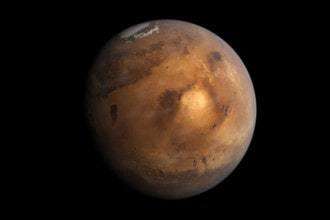
Dear EarthTalk: How far along are we on efforts to support large numbers of people on [ Mars ] or other planets if our population gets too big or we ruin the environment here on Earth?
— Barbara Christie, Hull, MA
As the human population swells and global warming compounds other environmental problems here on Earth, the notion of colonizing other planets is more appealing than ever. While we are far from being able to support human communities elsewhere in the solar system and beyond, environmentalists are increasingly interested in space exploration as one potential solution to our own earthly woes.
Mars is by far the most promising planet in the solar system on which we could support substantial human life. Currently, Mars is a desolate desert, but the so-called “red planet” once contained liquid water and perhaps harbored life. Many of the elements we depend upon to support life here on Earth, including carbon, silicon, iron and even frozen water, are present on Mars, giving researchers hope that one day some of us could hopscotch through space and set up shop there.
The first challenge of colonizing Mars is transportation. The furthest a manned mission has ever gone to date is the moon, and Mars is 140 times further away. Currently the biggest hurdle is the cost of spaceflight. But a new breed of private companies such as SpaceX and Blue Origin have invested in making launching more efficient by streamlining manufacturing and even reusing rockets. Elon Musk, CEO of SpaceX, claims he can reduce the cost of spaceflight 100-fold.
The best concrete plan for landing humans on Mars is called Mars Direct. Designed by aerospace engineer and Mars Society founder Bob Zubrin, this plan was rejected by NASA because it failed to fully utilize new technologies such as the International Space Station. Zubrin thinks we could get ourselves to Mars for only $55 billion, which seems like a bargain compared to the $250 billion figure suggested for a Mars landing back in 1969 after our first moon landing.
The most immediate problem for human habitation on Mars is the severe temperature. The average temperature on the surface of the red planet is -67° Fahrenheit compared to the balmy 61° here on Earth. Elon Musk suggests there are two ways to overcome this obstacle. The fast way would be by dropping nuclear weapons on Mars’ poles, while a slower solution would entail emitting huge amounts of carbon into the Martian atmosphere much as we are doing on Earth but to a larger extent. In theory, this carbon seeding plan would cause the atmosphere to grow and eventually shield much of the radiation that would otherwise be harmful to Martians. Since carbon dioxide is the main gaseous nutrient consumed by plants, it’s possible that many plants could thrive on Mars. Without competition, plants could take over the planet and put oxygen into the atmosphere, eventually making it possible for humans and other animals to populate Mars without oxygen masks.
There are still problems with colonizing Mars, however. Its low gravity would corrode human bones and giant storms rage across the currently barren planet. In sharp contrast, Earth is rich in resources and water, making it naturally habitable for plants and animals. Addressing the problems here on Earth will likely be easier than escaping them by fleeing to Mars or other planets.
CONTACTS: NASA, www.nasa.gov; Blue Origin, www.blueorigin.com; SpaceX, www.spacex.com; The Mars Society, www.marssociety.org.
EarthTalk® is produced by Roddy Scheer & Doug Moss and is a registered trademark of the nonprofit Earth Action Network. To donate, visit www.earthtalk.org. Send questions to: question@earthtalk.org.


Building self-sustaining colonies on Luna, Mars, or in space itself is an excellent solution to our climate woes. This is not because they are ‘lifeboats’ or provide an ‘escape route’ (although they might eventually do that) — instead, it is because of the recycling (and other) technologies required to make those colonies viable in the first place. Those technologies will be useful on Earth too; and the life-or-death drive to improve them to increase the viability of colonies is a strong motivation to improve life on Earth.
Comments are closed.